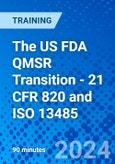The FDA has been working to align its QSR with the worldwide quality systems standard ISO 13485. Part of the reason for harmonizing its regulations with ISO 13485 is to reduce the regulatory burden for device makers who sell product in both the US and in EU/Asia, by eliminating redundancies involved in complying with both the ISO and QSR standards. After years of reviews, the Agency has “determined that the requirements in ISO 13485 are, when taken in totality, substantially similar to the requirements of the current Part 820, providing a similar level of assurance in a firm’s quality management system and ability to consistently manufacture devices that are safe and effective and otherwise in compliance with the FD&C Act.” They base this decision on their participation in the Medical Device Single Audit Program (MDSAP), as well as a previous audit report pilot program in which the Agency accepted manufacturers' audit reports based on ISO 13485 (-:2003). FDA agrees that ISO 13485 represents a more modern QMS approach and “has greater integration of risk management activities and stronger ties to ISO 14971, the risk management standard for medical devices'. The FDA proposes to give manufacturers one year from the publication of the final rule to adapt to the new regulatory requirements.
Why You Should Attend:
This webinar will discuss What the new QMSR will require. A key element is the incorporation of ISO 13485 into the new 820 by reference. Major emphasis will be upon risk management in accordance with ISO 14971 (-:2019), which currently has only casual reference in 820.30. The FDA views risk management as an “essential systematic practice” to ensure that devices are safe and effective. If the proposed rule is finalized, it will enhance some parts of ISO 13485. Device manufacturers will need to enhance risk management procedures for specific devices and in all other areas of their businesses to align with the QMSR. Design Control (ISO 13485 7.3 Design and Development) will have limited application to Class I devices, but fully involve Class II and III (US classifications) as is currently done in the US but not the EU. Traceability of implantables will be emphasized more than in ISO 13485. The QMSR will re-empbasize senior mangement's importance establishing and following a policy of quality, and a company culture of quality. The concept and definition of the make-up and role of'the customer', a term familiar to ISO but not the old QSR. There are other changes which will be discussed during this webinar. Combination products, 21 CFR 4, will be modified to include reference to ISO 13485 as well. QSIT will be changed. The FDA's new inspection program would not be a substitute for an ISO 13485 certification procedure if one is required, nor would those who hold an ISO 13485 certificate be exempt from FDA inspection. Once approved, there will be a one year transition period allowed.Course Content
- Introduction to the QMSR
- 'Incorporation by reference' ISO 13485
- The new 21 CFR 820
- Key Changes
- Major Areas of Emphasis over ISO 13485
- Incorporation of risk management throughout the quality system based on ISO 14971
- Phase-in period
Speakers
John E. LincolnJohn E. Lincoln, is Principal of J. E. Lincoln and Associates LLC, a consulting company with over 36 years experience in U.S. FDA-regulated industries, 22 of which are as an independent consultant. John has worked with companies from start-up to Fortune 100, in the U.S., Mexico, Canada, France, Germany, Sweden, China and Taiwan. He specializes in quality assurance, regulatory affairs, QMS problem remediation and FDA responses, new/changed product 510(k)s, process/product/equipment QMS and software validations, ISO 14971 product risk management files/reports, Design Control/Design History Files, Technical Files, CAPA systems and analysis.
He’s held positions in Manufacturing Engineering, QA, QAE, Regulatory Affairs, to the level of Director and VP (R&D). In addition, John has prior experience in military, government, electronics, and aerospace. He has published numerous articles in peer reviewed journals, conducted workshops and webinars worldwide on CAPA, 510(k)s, risk analysis/management, FDA/GMP audits, validation, root cause analysis, and others. He writes a recurring column for the Journal of Validation Technology. John is a graduate of UCLA.








